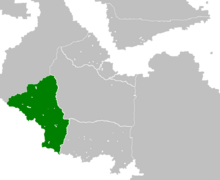Republic of Libertarya
This article is incomplete because it is pending further input from participants, or it is a work-in-progress by one author. Please comment on this article's talk page to share your input, comments and questions. Note: To contribute to this article, you may need to seek help from the author(s) of this page. |
Republic of Libertarya Komaria Libertarya | |||||||||
|---|---|---|---|---|---|---|---|---|---|
| 1840–1955 | |||||||||
|
Flag of Libertarya (1909 - 1955) | |||||||||
 The borders of the Republic of Libertarya 1909 - 1955 | |||||||||
| Status | Republic | ||||||||
| Capital | Bajazad (1844 - 1955) | ||||||||
| Common languages | Basaquese, Santian, Fayrean | ||||||||
| Government | Unitary parliamentary republic | ||||||||
| Chancellor | |||||||||
• 1844-1850 | Qasim Kaivan | ||||||||
• 1951-1955 | Alexandre Delon | ||||||||
| Legislature | Parliament of Libertarya | ||||||||
| History | |||||||||
• Proclamation of independence | 25th June 1840 | ||||||||
• Recognition of independence | 6th May 1844 | ||||||||
• Unification of Liberto-Ancapistan | 21st March 1955 | ||||||||
| Currency | Libertaryan Fiat | ||||||||
| |||||||||
The Republic of Libertarya (Basaquese: Komaria a Libertarya) was a republic in southern Basaquastan which existed between 1840 and 1955. The republic was the largest sovereign state by population in Basaquastan before the unification of Liberto-Ancapistan, comprising all of modern-day Libertarya Province, Bajazad Province, the district of Ciona-Libertarya in modern-day Rojava-Navenda Province, and the Fayre Islands.
The republic was formed during the 1840 Summer Revolution, when members of the Society of Libertarians staged an uprising against the Santian Empire in the cities of Girav and Bakur, and created a state spanning the historical region of Libertarya. Founded on radical principles, it was a representative democracy with universal sufferage and a written constitution, but was dominated by the Society of Libertarians and its successor the Libertarian Party for most of its existence. The first region of Basaquastan to industrialise, beginning in the 1890s, it saw significant overseas immigration and economic growth. As the largest and wealthiest predecessor state of Liberto-Ancapistan, its constitution and government form much of the basis for the modern state of Liberto-Ancapistan, and its last chancellor, Alexandre Delon, became the first chancellor of the new federal republic.
